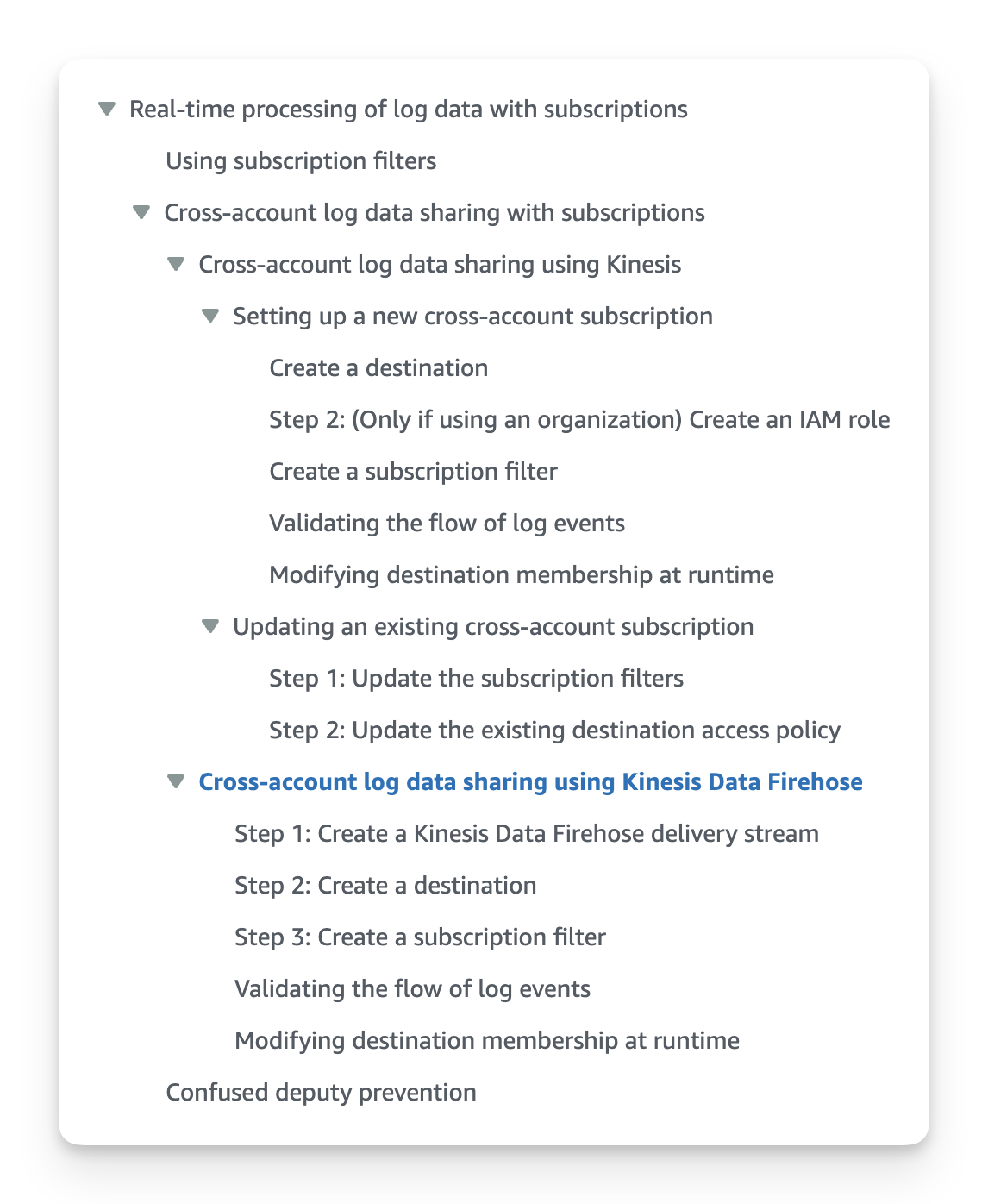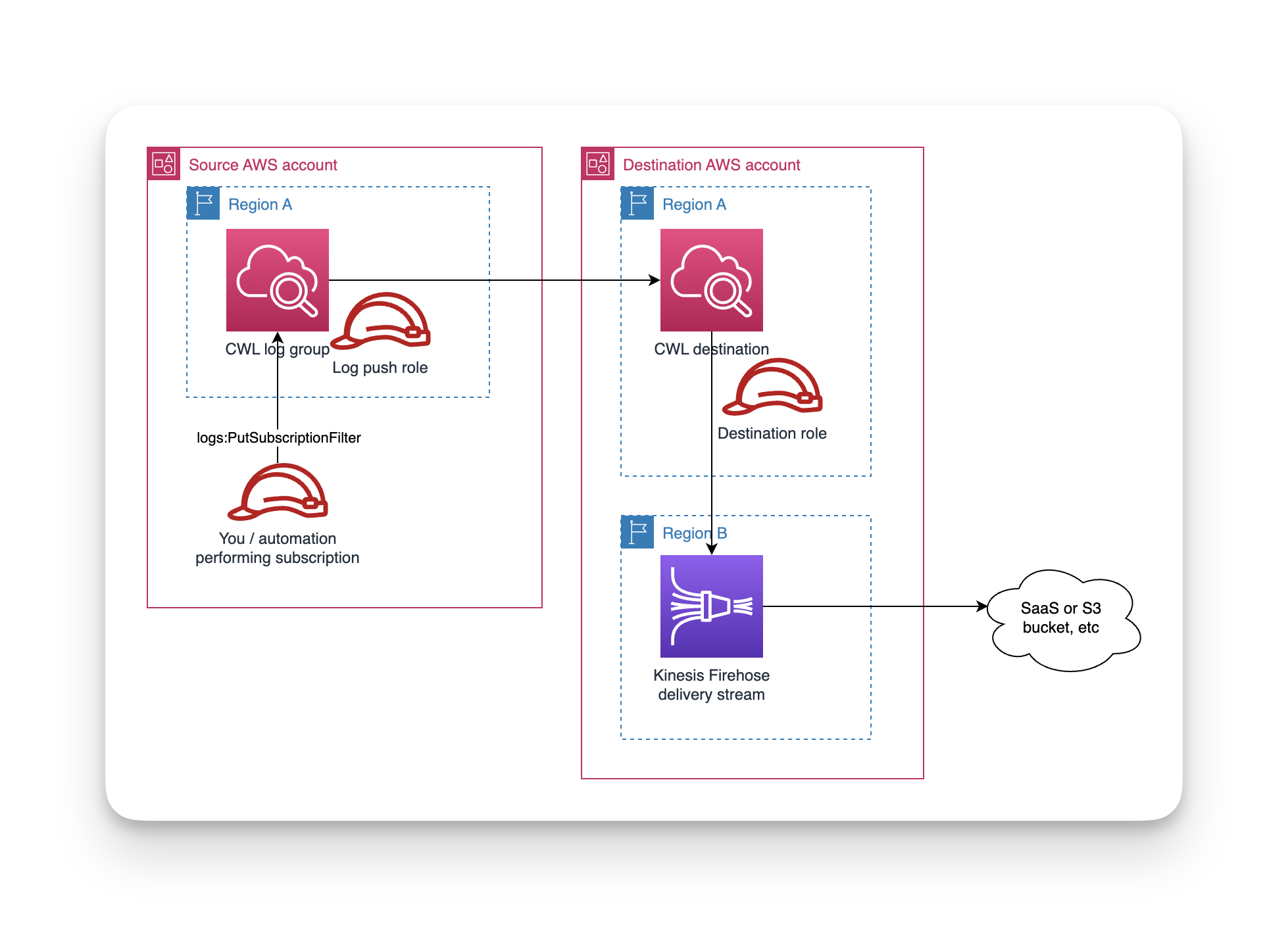Centralised logging: from CloudWatch to Kinesis Firehose
AWS CloudWatch Logs supports automatic forwarding of logs to AWS Kinesis Data Streams and AWS Kinesis Data Firehose. These destinations are can even be in a different AWS account and region. This is very handy for aggregating logs from thousands of log groups and forwarding them to a single place, like Axiom, Datadog, Splunk, etc.
The only problem is that the docs are (to me, anyway) very confusing. They're also very long. Look at this!

So this post is an attempt to explain it in my own words for a) me in the future when I forget all this and b) others who might stumble across it. I'm going to focus on Kinesis Data Firehose delivery streams as that is more interesting to me, but the same applies to Kinesis Data Streams.
Centralised logging¶
Here is a diagram of the relevant parts. I've made it multiple region and multiple account to demonstrate the most complex configuration. It also works in single region configurations too.

First, we'll start with the straightforward part: a template that deploys the delivery stream, a role for the delivery stream and a backup bucket. This only needs to be deployed to a single region in the logs destination account.
Parameters:
DeliveryStreamName:
Type: String
Default: centralised-logs
APIKey:
Type: String
NoEcho: true
Resources:
Firehose:
Type: AWS::KinesisFirehose::DeliveryStream
Properties:
DeliveryStreamName: !Ref DeliveryStreamName
DeliveryStreamType: DirectPut
HttpEndpointDestinationConfiguration:
RoleARN: !GetAtt FirehoseRole.Arn
BufferingHints:
IntervalInSeconds: 60
SizeInMBs: 4
EndpointConfiguration:
Name: example
Url: https://example.com
AccessKey: !Ref APIKey
RequestConfiguration:
ContentEncoding: GZIP
RetryOptions:
DurationInSeconds: 60
S3BackupMode: AllData
S3Configuration:
BucketARN: !Sub arn:aws:s3:::${Bucket}
RoleARN: !GetAtt FirehoseRole.Arn
Prefix: logs/!{timestamp:yyyy/MM/dd}/
ErrorOutputPrefix: errors/!{firehose:error-output-type}/!{timestamp:yyyy/MM/dd}/
CompressionFormat: GZIP
BufferingHints:
IntervalInSeconds: 60
SizeInMBs: 128
FirehoseRole:
Type: AWS::IAM::Role
Properties:
AssumeRolePolicyDocument:
Version: "2012-10-17"
Statement:
- Effect: Allow
Principal:
Service: firehose.amazonaws.com
Action: sts:AssumeRole
Condition:
StringEquals:
sts:ExternalId: !Ref AWS::AccountId
Policies:
- PolicyName: Firehose
PolicyDocument:
Version: "2012-10-17"
Statement:
- Effect: Allow
Action:
- s3:AbortMultipartUpload
- s3:GetBucketLocation
- s3:GetObject
- s3:ListBucket
- s3:ListBucketMultipartUploads
- s3:PutObject
Resource:
- !Sub arn:aws:s3:::${Bucket}
- !Sub arn:aws:s3:::${Bucket}/*
Bucket:
DeletionPolicy: Retain
Type: AWS::S3::Bucket
Outputs:
FirehoseArn:
Value: !GetAtt Firehose.Arn
Delivery streams do not have resource-based policies, so by themselves they have no way of permitting cross-account publishing. To resolve this, CloudWatch introduces the concept of "logical destinations". These are abstractions that wrap a delivery stream (or Kinesis data stream) and add a) a role that the destination itself assumes when publishing to the delivery stream and b) a resource-based destination policy that specifies who is permitted to forward logs to this destination.
CWL log groups can only forward logs to a CWL destination in the same region, but a CWL destination can publish those logs to a delivery stream in a different region. Therefore, my preferred pattern is to deploy this CloudFormation template to the "logs destination" account in every region my org uses.
# this line lets us use `Fn::ToJsonString` below
Transform: AWS::LanguageExtensions
Parameters:
FirehoseArn:
Type: String
Default: arn:aws:firehose:us-east-1:0123456789012:deliverystream/centralised-logs
OrgId:
Type: String
Default: o-abc123
Resources:
Destination:
Type: AWS::Logs::Destination
Properties:
DestinationName: CentralisedLogs
RoleArn: !GetAtt DestinationRole.Arn
TargetArn: !Ref FirehoseArn
DestinationPolicy:
Fn::ToJsonString:
Version: '2012-10-17'
Statement:
- Sid: AllowMyOrg
Effect: Allow
Principal: "*"
Action: logs:PutSubscriptionFilter
Resource: !Sub arn:aws:logs:${AWS::Region}:${AWS::AccountId}:destination:CentralisedLogs
Condition:
StringEquals:
aws:PrincipalOrgID: !Ref OrgId
DestinationRole:
Type: AWS::IAM::Role
Properties:
AssumeRolePolicyDocument:
Version: "2012-10-17"
Statement:
- Effect: Allow
Principal:
Service: logs.amazonaws.com
Action: sts:AssumeRole
Policies:
- PolicyName: Firehose
PolicyDocument:
Version: "2012-10-17"
Statement:
- Effect: Allow
Resource: !Ref FirehoseArn
Action: firehose:PutRecord*
# the AWS docs say to grant "firehose:*" -- how weird is that?
Outputs:
DestinationArn:
Value: !GetAtt Destination.Arn
With that deployed, our logs destination account is completely setup. We can move onto the source accounts. In those accounts we deploy this template:
Parameters:
LogPusherRoleName:
Type: String
Default: CentralisedLogsPusher
Resources:
LogPusherRole:
Type: AWS::IAM::Role
Properties:
RoleName: !Ref LogPusherRoleName
AssumeRolePolicyDocument:
Version: "2012-10-17"
Statement:
- Effect: Allow
Action: sts:AssumeRole
Principal:
Service: logs.amazonaws.com
Policies:
- PolicyName: PutLogEvents
PolicyDocument:
Version: "2012-10-17"
Statement:
- Effect: Allow
Action: logs:PutLogEvents
Resource: "*"
# why does it need this permission? not sure. it's what the docs
# say and i haven't yet tested if it works without it.
# https://docs.aws.amazon.com/AmazonCloudWatch/latest/logs/CreateSubscriptionFilter-IAMrole.html
Outputs:
LogPusherRoleArn:
Value: !GetAtt LogPusherRole.Arn
Now you can finally create a subscription filter that forwards logs for a given log group to that centralised delivery stream (via a CWL destination). Here's how to do that:
aws logs put-subscription-filter \
--log-group-name /aws/lambda/example-log-group \
--filter-name CentralisedLogging \
--filter-pattern '' \
--destination-arn arn:aws:logs:ap-southeast-2:0123456789012:destination:CentralisedLogs \
--role-arn arn:aws:iam::987654321012:role/CentralisedLogsPusher
Note that the principal calling logs:PutSubscriptionFilter will need permission
to call that action on the given log group and iam:PassRole on the log pusher
role ARN.